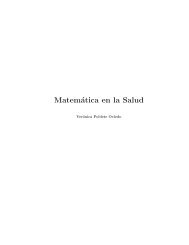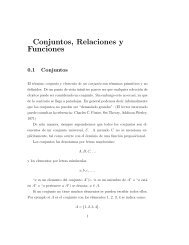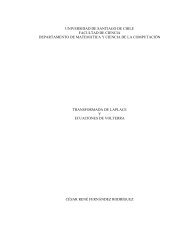Apuntes de Variable Compleja - Carlos Lizama homepage ...
Apuntes de Variable Compleja - Carlos Lizama homepage ...
Apuntes de Variable Compleja - Carlos Lizama homepage ...
You also want an ePaper? Increase the reach of your titles
YUMPU automatically turns print PDFs into web optimized ePapers that Google loves.
2.1. FUNCIONES ANALÍTICAS 9<br />
en que:<br />
e(x − x0, y − y0)<br />
<br />
(x − x0) 2 → 0<br />
+ (y − y0) 2<br />
cuando x → x0 y y → y0, esto es, el error es pequeño comparado con la norma.<br />
Observar que L : R2 → R2 es una aplicación lineal cuya matriz, con respecto a<br />
las bases canónicas, es:<br />
⎛<br />
⎜<br />
[L] = ⎜<br />
⎝<br />
∂f1<br />
∂x (x0, y0) ∂f1<br />
∂y (x0, y0)<br />
∂f2<br />
∂x (x0, y0) ∂f2<br />
∂y (x0, y0)<br />
La prueba <strong>de</strong>l siguiente resultado se ve usualmente en cursos <strong>de</strong> cálculo por<br />
lo que no se mostrará aqui.<br />
Teorema 14 Si ∂f ∂f<br />
,<br />
∂x ∂y existen y son continuas en (x0, y0) entonces f es diferenciable<br />
en ese punto.<br />
⎞<br />
⎟<br />
⎠ .<br />
La siguiente es una <strong>de</strong> las principales caracterizaciones <strong>de</strong> funciones analiticas.<br />
Teorema 15 (Ecuaciones <strong>de</strong> Cauchy-Riemann) Sea f = u+v una función diferenciable<br />
en z0 = (x0, y0). Entonces f es holomorfa en z0 si y sólo si se cumplen<br />
las ecuaciones: ∂u<br />
∂x<br />
∂v ∂u<br />
= ,<br />
∂y ∂y<br />
Demostración.<br />
(⇒)Por <strong>de</strong>finición, se tiene que<br />
f(z0 + t) − f(z0)<br />
lím<br />
t→0 t<br />
equivalentemente<br />
o bien<br />
= −∂v<br />
∂x en el punto (x0, y0).<br />
f(z0 + it) − f(z0)<br />
= lím<br />
t→0 t<br />
u(z0 + t) + iv(z0 + t) − u(z0) − iv(z0)<br />
lím<br />
t→0<br />
t<br />
= 1<br />
i lím<br />
u(z0 + it) + iv(z0 + it) − u(z0) − iv(z0)<br />
t→0<br />
t<br />
<br />
u(z0 + t) − u(z0)<br />
lím<br />
t→0 t<br />
= lím<br />
t→0<br />
u(z0 + it) − u(z0)<br />
t<br />
+ i v(z0<br />
<br />
+ t) − v(z0)<br />
t<br />
+ iv(z0 + it) − v(z0)<br />
t<br />
<br />
.







